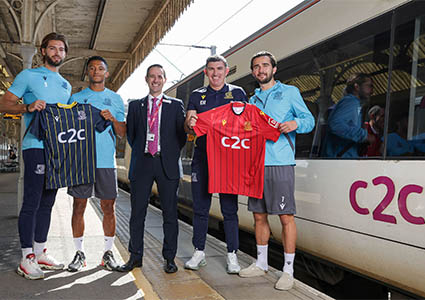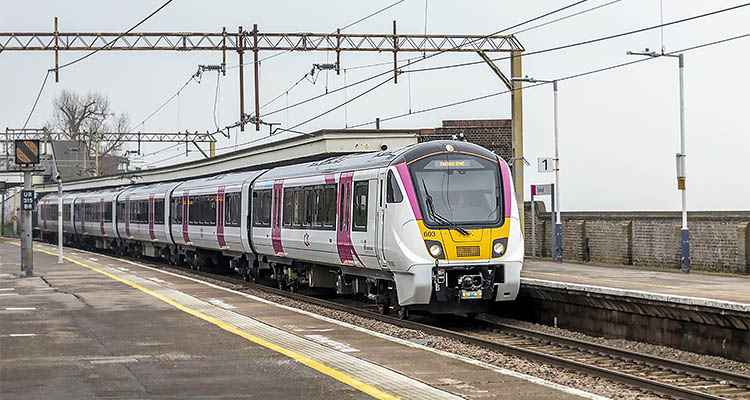How c2c Rail is responding to its new commercial challenges
Part of the Italian transportation firm Trenitalia is c2c Rail (c2c), an award-winning UK-based train operator running services between London Fenchurch Street and Shoeburyness. Widely recognized as one of the UK’s most punctual and popular train operators, the company serves 26 stations in East London and South Essex. Steve Knights, Head of Commercial Growth at c2c, gives us a valuable insight into the company’s evolution, history, and promising growth aspirations.
“Back in the 1990s, c2c used to be known as the Misery Line,” he opens. Keen to transform this negative reputation, c2c made significant investments around the turn of the century, with new trains, station refurbishments, and the widespread implementation of ticket gates. “From the late 1990s, the company was held by National Express before it was acquired in 2017 by Trenitalia, the Italian state railway. To this day, Trenitalia remains our owning group,” Steve continues.
“Geographically, we operate from London to Southend-on-Sea (Southend) in Essex, via the Essex Thameside area known locally as the ‘Essex Riviera’, all the way down to Shoeburyness at the end of the line. Essentially, we link communities in East London and South Essex with the cities of London and Southend. Though it is not necessarily a nationally recognized brand, c2c is well-known locally for taking commuters from South Essex to the City of London and the Docklands, tourists and day-trippers to the beaches, parks and attractions of Chalkwell, Leigh-on-Sea and Southend-on-Sea, and students to the various secondary schools, colleges and university sites located right across the route. In fact, we have always had a commuter-dominated customer base, with about 75 percent of our journeys falling under this category prior to the pandemic. However, this proportion, as is the case with all train operating companies serving London from the home counties, decreased during and after the pandemic,” he says.
Sustainable services
It is no secret that the pandemic has had devastating impacts on many industries, with transportation one of the worst hit due to the travel restrictions that ensued and subsequent changes to customers’ working patterns, shopping and leisure travel habits. Nonetheless, for c2c, this difficult period brought about a number of new and positive developments. “We have enjoyed closer and stronger working relationships with many of our key stakeholder partners since the pandemic, including officials at the Department for Transport (DfT).
“Like the majority of UK rail companies, we have historically worked under fixed-length franchise contracts let out by the DfT. However, these contracts ended during the pandemic, as they were replaced with shorter term ones. Notably, the new contracts require yearly accountability to the DfT on our spending and outputs. With the new government’s proposals for nationalization and public ownership of the railways, this partnership working is likely to continue,” Steve informs.
c2c’s recently launched net-zero strategy, a ten-year plan to build a successful and sustainable railway for colleagues, customers and communities, is another key component of its vision for the future. Net Zero is about offering sustainable services to communities while also focusing on becoming a profitable business. The team at c2c has an important role to play in the delivery of this strategy; whether working at a station, in a depot, at head office or at the Service Delivery Centre, and the organization has worked hard to ensure that everyone is clear on the impact they can have on the successful delivery of it.
Creative marketing campaigns
Steve goes on to discuss c2c’s summer marketing strategy, a clear example of its investment in revenue growth, which forms a major component of the net-zero strategy. “Summer is an important time of year for us, as there are two major leisure destinations on our route: London (which, of course, is relevant all year round) and Southend and its surrounding area, known for its beaches, theme parks, green spaces and tourist attractions. Naturally, Southend is a big draw in the summer when the weather is warm, and in the last three weeks [at time of writing], we have been lucky enough to experience good weather coinciding with the start of the school holidays. So, our summer marketing campaign is focused on releasing a series of creative content that gives customers ideas of places to visit both in London and around Southend, while highlighting our great value for money fares. For instance, we offer a ‘kids for £2’ return ticket during weekends and school holidays, which is excellent value and extremely competitive in comparison to other modes of travel. 
“Moreover, we have a media marketing plan that spans different types of platforms, from station posters placed in East London underground stations to online channels such as TikTok, which we have started using this year. Our fast-growing TikTok presence enables us to reach a younger audience, a key and important part of our market. “Additionally, we are using connected TV for the first time, allowing us to advertise on TV using digital TV services closely targeted to our market. By using different and new channels, we aim to increase awareness of c2c and our services to a wider audience and ultimately encourage a greater number of ticket purchases throughout the summer season. It is also worth noting that we have incorporated weather-reactive elements into our campaigns, some manual and some automated. When the weather is sunny and warm, we will heavily promote trips to Southend and other beaches within reach of London, thus encouraging customers to make the most of the good weather and travel on our services to some of the many great places we serve,” Steve elaborates.
Ancillary revenue strategies
To continue its ongoing marketing efforts, c2c is expanding its marketing team, a further demonstration of its commitment to achieving Net Zero. However, the company’s growth strategy is also focused on exploring new revenue streams and expanding commercial opportunities. Steve details the various facets of this clever strategy. “We are changing our working culture and practices, and as a result have developed new management dashboards that allow us to visualize our trading activities and revenue on a daily or weekly basis. Although this may not seem like a significant innovation, these figures have proved invaluable, allowing us to protect existing revenue while looking at new opportunities and generating growth. Furthermore, we are in the process of expanding and reorganizing the marketing team as well as other parts of my commercial team, with plans to recruit more members – including analysts, marketeers and administrative support – which will further enhance our ability to deliver on our ambitious plans. As a result, the commercial team will increase from eight members to 14, and it will be retitled the Commercial Growth team.
“In the past, the responsibility for business-to-business ancillary revenue operations had been split across different directorates. Now, the commercial team will be fully in charge of them, generating revenue from car parks, property lettings, and commercial advertising, in addition to ticket sales. Beyond this, we are exploring further opportunities to drive revenue, such as allowing film crews to access our stations and trains for a fee. Having a stronger, dedicated and more focused commercial team in place is essential to successfully tapping into these additional revenue streams. While we can only do so much to influence ticket sales, we can and will diversify our ancillary revenue strategies to maximize income from non-fare revenue streams. This will be a key part of ensuring that moving forward c2c is a financially sustainable and profitable operation,” he enlightens.
Before concluding our interview, Steve mentions a recent investment c2c has made in line with its ESG goals. “A few weeks ago, we announced a partnership and front of shirt sponsorship with Southend United Football Club. This will allow us to connect with the local community – a shared goal (pardon the pun!) of both organizations – all while creating greater visibility for c2c,” he ends.
